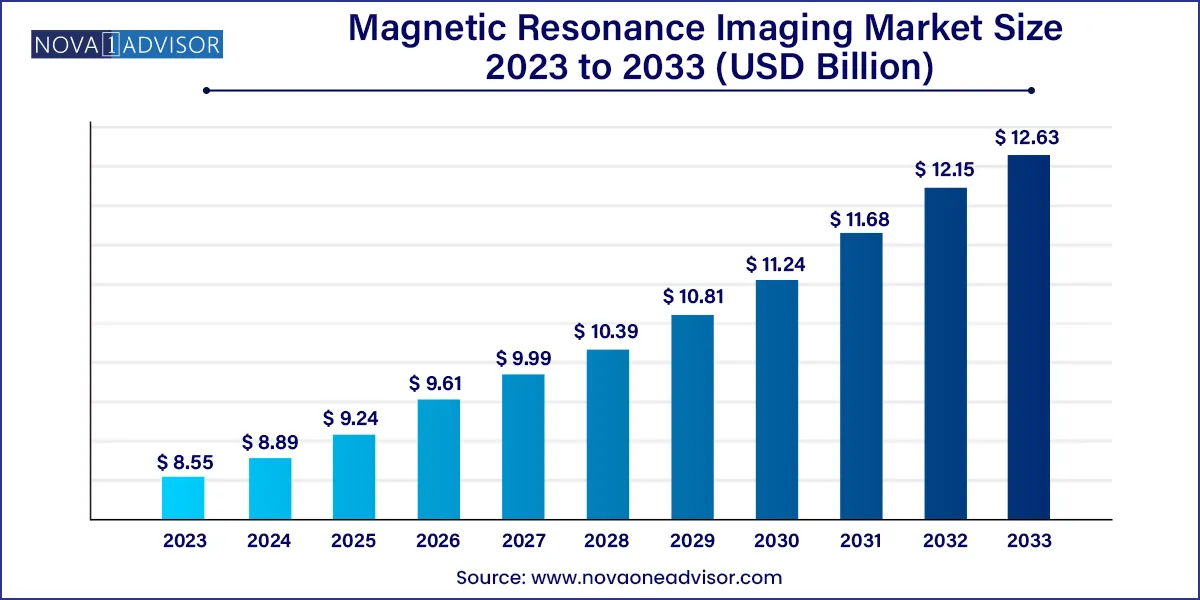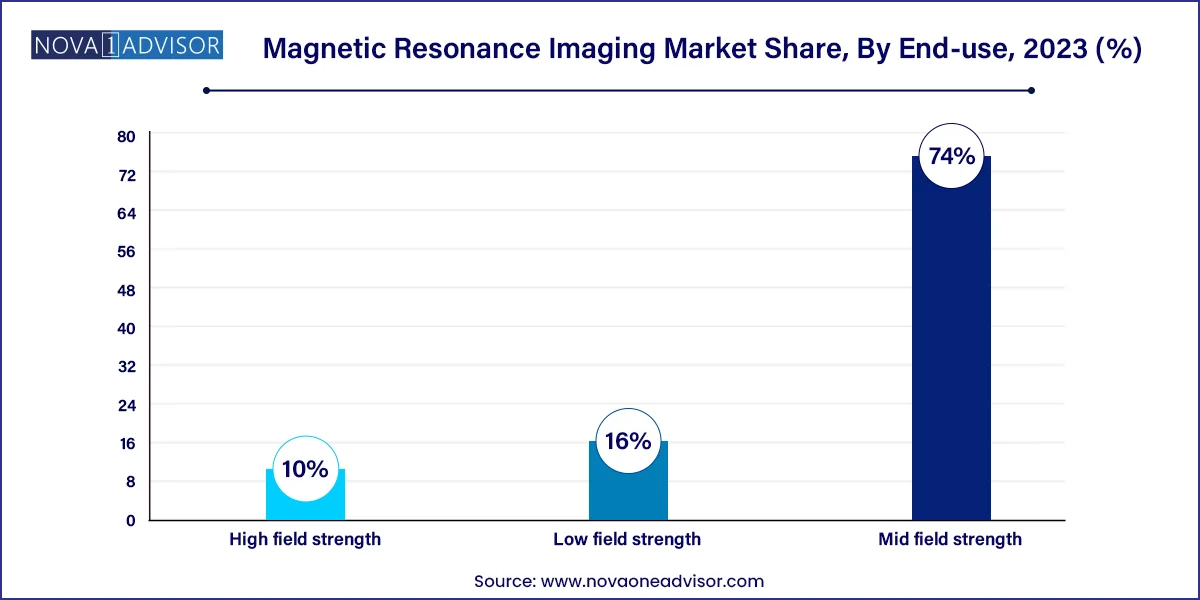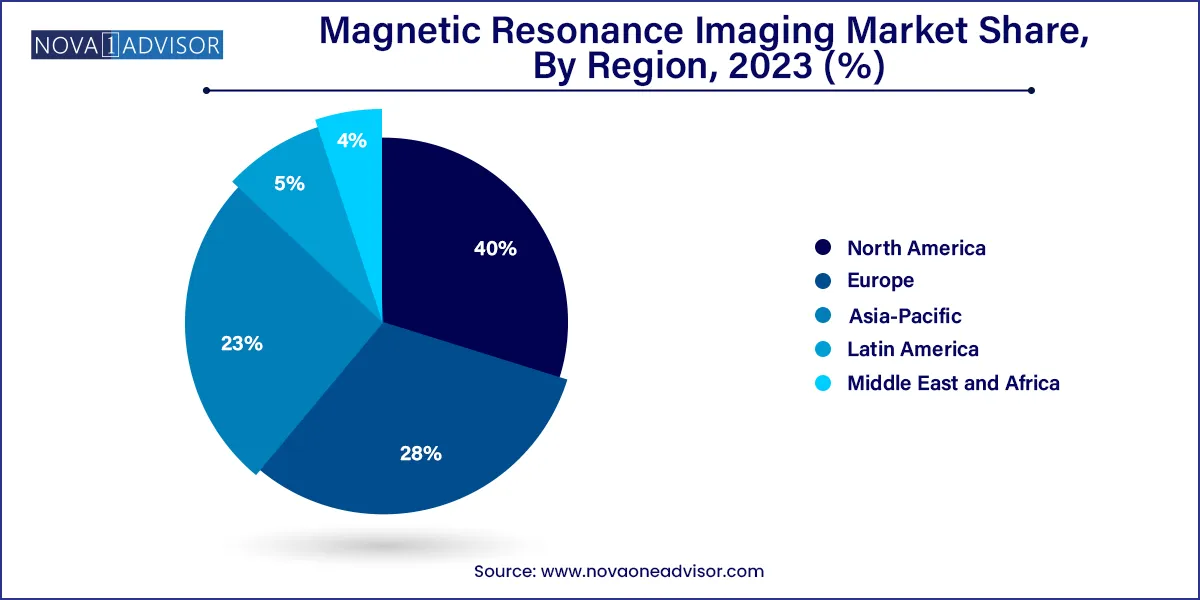The global magnetic resonance imaging market size was exhibited at USD 8.55 billion in 2023 and is projected to hit around USD 12.63 billion by 2033, growing at a CAGR of 3.98% during the forecast period 2024 to 2033.

Key Takeaways:
- North America has generated a 40% market share in 2023.
- By strength, the midfield strength segment reached a 74% market share in 2023.
- By end user, the hospital segment held the largest share in 2023.
- By, the closed MRI system segment has contributed the highest market share in 2023.
Market Overview
The Magnetic Resonance Imaging (MRI) market represents a pivotal sector in diagnostic imaging, instrumental in the early detection and precise diagnosis of numerous medical conditions. MRI technology, leveraging strong magnetic fields and radio waves, provides high-resolution, non-invasive imaging without exposure to ionizing radiation, making it ideal for repeated use and complex tissue differentiation. Its applications span across neurology, musculoskeletal, cardiovascular, and oncological imaging, among others.
The market has evolved significantly with technological advancements, shifting from bulky and stationary systems to portable and high-field strength devices. Integration with artificial intelligence (AI) has also elevated diagnostic accuracy, automated image interpretation, and reduced time-to-diagnosis. Additionally, the growing geriatric population, who are more susceptible to chronic and degenerative diseases, has driven an uptick in demand for MRI scans globally.
As of 2025, the market is characterized by robust competition, high R&D spending, and strategic collaborations between healthcare providers and manufacturers. While high costs and infrastructure requirements present barriers in low-income settings, innovations in open systems and mid-field strength MRI devices are facilitating wider adoption. Furthermore, increasing awareness, government health initiatives, and the expansion of private diagnostic chains are fueling growth in emerging economies.
Major Trends in the Market
-
AI and Machine Learning Integration: Enhanced image interpretation and diagnosis using deep learning algorithms.
-
Development of Silent MRI Systems: Reduction in noise levels during scans for improved patient comfort.
-
Portable and Compact MRI Devices: Introduction of mobile systems for point-of-care imaging in rural or emergency setups.
-
High-Field MRI Adoption: Surge in demand for 3T and above systems for superior image resolution, particularly in neurology.
-
Hybrid Imaging Systems: Combining MRI with PET or CT for comprehensive diagnostic capabilities.
-
Bio-based MRI Contrast Agents: Shift towards safer, non-metallic contrast agents reducing risk of nephrogenic systemic fibrosis.
-
Growing Application in Oncology: Increased use of MRI for tumor detection, therapy planning, and monitoring.
-
Reimbursement Reforms: Countries revamping insurance frameworks to include advanced diagnostic modalities like MRI.
-
Patient-centric Design Improvements: Wider bores and open systems designed for claustrophobic or pediatric patients.
-
Cloud-based Image Archiving and Tele-radiology: Allowing real-time access and consultation among multidisciplinary teams.
Magnetic Resonance Imaging Market Report Scope
| Report Coverage |
Details |
| Market Size in 2024 |
USD 8.89 Billion |
| Market Size by 2033 |
USD 12.63 Billion |
| Growth Rate From 2024 to 2033 |
CAGR of 3.98% |
| Base Year |
2023 |
| Forecast Period |
2024-2033 |
| Segments Covered |
Architecture, Type, Process, Field Strength, Application, End User, and Geography |
| Market Analysis (Terms Used) |
Value (US$ Million/Billion) or (Volume/Units) |
| Regional Scope |
North America; Europe; Asia Pacific; Central and South America; the Middle East and Africa |
| Key Companies Profiled |
GE Healthcare, Siemens AG, Toshiba Corporation, Aurora Imaging Technologies, Inc., Koninklijke Philips N.V., Esaote SPA, Sanrad Medical Systems Pvt ltd, Fujifilm |
Key Market Driver: Rising Chronic Disease Burden
A leading driver of the MRI market is the rising incidence of chronic diseases, particularly neurological disorders, musculoskeletal ailments, and cardiovascular conditions. As life expectancy increases, populations in both developed and developing regions are encountering age-related illnesses that necessitate advanced imaging for timely intervention. For example, the World Health Organization reported over 50 million cases of dementia globally, with MRI being crucial in diagnosing Alzheimer’s disease by assessing brain atrophy patterns.
In orthopedic diagnostics, MRI excels in detecting cartilage damage, ligament tears, and spinal abnormalities with precision, aiding in early surgical planning. Similarly, in cardiac care, MRI provides unparalleled clarity in evaluating myocardial structure and function, often superior to echocardiography. This widespread utility has made MRI an indispensable diagnostic tool, pushing healthcare systems and private providers to invest in newer, high-efficiency MRI units.
Key Market Restraint: High Operational Costs
Despite its benefits, the high cost of MRI systems and operations poses a major challenge, especially in resource-constrained settings. A standard high-field MRI machine can cost between $1 million to $3 million, excluding installation, maintenance, and shielding expenses. Moreover, operational requirements such as skilled radiologists, trained technicians, and constant electricity supply add to recurring costs.
These financial constraints limit access in rural areas and low-income countries, where healthcare budgets are already stretched. In addition, reimbursement limitations in some insurance systems deter patients from opting for MRI unless absolutely necessary. These factors collectively restrict the broader implementation of MRI services, despite growing clinical need.
Key Market Opportunity: Expansion in Emerging Markets
A promising opportunity lies in the expansion of MRI services in emerging markets, notably across Asia-Pacific, Latin America, and parts of Africa. As healthcare infrastructure improves in countries like India, Brazil, Indonesia, and South Africa, the demand for diagnostic imaging is surging. The proliferation of public-private partnerships (PPPs), rising insurance penetration, and government subsidies on diagnostic equipment are further catalyzing market penetration.
For instance, India’s Ayushman Bharat program includes imaging services under its umbrella, enhancing MRI scan accessibility for lower-income demographics. Additionally, manufacturers are developing region-specific, cost-efficient MRI systems with lower field strength but adequate image quality, tailored to suit clinical requirements in these areas.
Segments Insights:
By Architecture Insights
Closed MRI systems dominated the market due to their superior imaging capabilities and high field strength capacity. These systems, commonly found in tertiary hospitals and research centers, provide excellent image resolution critical for neurological and musculoskeletal evaluations. Despite the enclosed design being uncomfortable for some patients, the diagnostic accuracy offered by closed systems ensures their widespread adoption.
However, open MRI systems are the fastest-growing segment, particularly in pediatric, geriatric, and claustrophobic patient populations. These systems offer a more patient-friendly design with wider bores and horizontal openings. Although traditionally limited by lower field strengths, technological advancements have improved their imaging performance, making them suitable for a wider range of clinical applications. They are increasingly popular in outpatient diagnostic centers and rural settings.
By Field Strength Insights
Conventional MRI systems remain the market leader, accounting for a significant share due to their established clinical utility and availability. These machines form the backbone of diagnostic radiology departments worldwide, supported by a wide range of accessories, contrast media, and radiology expertise. Their robustness and versatility make them a preferred choice in both public and private healthcare sectors.
Bio-based MRI systems are emerging rapidly, especially as sustainability and patient safety gain traction. These systems use biodegradable materials and eco-friendly cooling mechanisms, aligning with green healthcare initiatives. Moreover, innovations in bio-compatible contrast agents that reduce nephrotoxicity risks are making bio-based approaches more viable and attractive for long-term use.
By Application Insights
Brain and neurological imaging leads the application segment, given the non-invasive and detailed assessment of brain tissue that MRI provides. From tumors and aneurysms to multiple sclerosis and epilepsy, MRI has revolutionized the diagnosis and monitoring of neurological conditions. Functional MRI (fMRI) further extends its utility into research and cognitive studies.
Cardiac applications are witnessing the fastest growth, propelled by the increasing prevalence of cardiovascular diseases. Cardiac MRI offers a radiation-free, high-resolution assessment of heart structure and function, outperforming traditional echocardiography in several parameters. It is increasingly being used in myocardial viability testing, congenital heart disease assessment, and stress perfusion studies.
By End User Insights
Hospitals dominate the end-user landscape, accounting for the largest share owing to the volume of patient inflow, advanced infrastructure, and skilled staff. MRI machines in hospitals are often integrated with electronic medical records (EMRs), allowing for seamless diagnostics and multidisciplinary collaboration, especially in emergency and trauma care.

However, ambulatory surgical centers (ASCs) and imaging centers are the fastest-growing users, driven by the trend toward outpatient care. These facilities offer cost-effective, fast, and high-quality diagnostic imaging services, making them a preferred choice for insurers and patients alike. Their agility in adopting the latest MRI technologies also supports faster market penetration.
By Regional Insights
North America holds the largest market share in the global MRI landscape, driven by advanced healthcare systems, high patient awareness, and substantial healthcare spending. The U.S. leads with a dense concentration of MRI units per capita, widespread insurance coverage, and strong reimbursement policies. Academic collaborations with tech firms like GE Healthcare and Siemens Healthineers have resulted in continual innovation and clinical research using MRI.

Furthermore, the presence of major MRI manufacturers headquartered in the region provides access to cutting-edge technology, training, and support. For instance, the integration of AI into MRI workflows, such as in GE’s AIR Recon DL, first launched in the U.S., has set new standards in image enhancement and scan time reduction.
Asia-Pacific is the fastest-growing region, bolstered by rising healthcare investments, increasing chronic disease burden, and expanding diagnostic infrastructure. Countries like China, India, and South Korea are leading the charge with rapid hospital expansion and government-funded radiology upgrades. The region is also a hub for cost-effective medical device manufacturing, driving down equipment costs and enabling broader access.
Notably, India’s “Make in India” initiative has encouraged domestic manufacturing of medical devices, including MRI systems. Furthermore, growing medical tourism in Southeast Asia, where MRI scans are competitively priced, has contributed to regional growth. As patient volumes increase, Asia-Pacific is expected to become a significant contributor to the global MRI market.
Recent Developments
-
Philips (March 2025) launched its new BlueSeal MRI system in Europe, a helium-free design aimed at reducing environmental impact and maintenance complexity.
-
GE HealthCare (January 2025) announced the deployment of over 1,000 AIR Recon DL-equipped MRI systems across North America, enhancing image quality with deep learning.
-
Siemens Healthineers (February 2025) introduced MAGNETOM Cima.X, a 3T MRI scanner with expanded clinical applications and reduced energy consumption.
-
United Imaging (December 2024) opened a new production facility in Texas, aiming to localize supply for high-field MRI systems in North America.
-
Canon Medical Systems (November 2024) received FDA clearance for its Vantage Fortian MRI, emphasizing workflow automation and quiet scan technology.
Some of the prominent players in the Magnetic resonance imaging market include:
- GE Healthcare
- Siemens AG
- Toshiba Corporation
- Aurora Imaging Technologies, Inc.,
- Koninklijke Philips N.V.,
- Esaote SPA,
- Sanrad Medical Systems Pvt ltd,
- Fujifilm
Segments Covered in the Report
This report forecasts revenue growth at global, regional, and country levels and provides an analysis of the latest industry trends in each of the sub-segments from 2021 to 2033. For this study, Nova one advisor, Inc. has segmented the global magnetic resonance imaging market.
By Architecture
- Closed system
- Open system
By Type
By Process
- Trans-Esterification
- Direct Esterification
By Field Strength
- Mid field strength
- Low field strength
- High field strength
By Application
- Obstructive sleep apnea
- Brain and neurological
- Spine and musculoskeletal
- Vascular
- Abdominal
- Cardiac
- Breast
- Others
By End User
- Imaging centers
- Hospitals
- Ambulatory surgical centers
- Others
By Region
- North America
- Europe
- Asia-Pacific
- Latin America
- Middle East & Africa (MEA)



